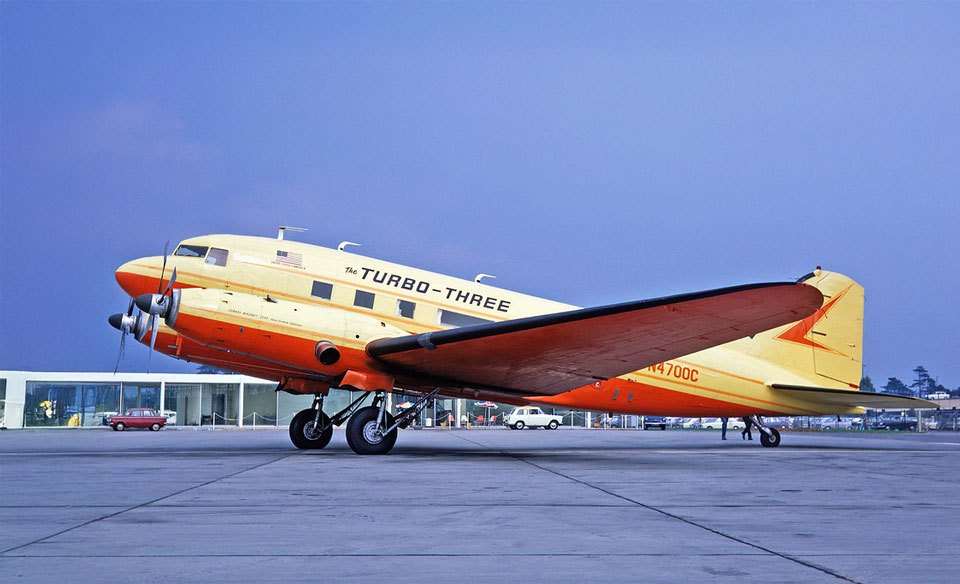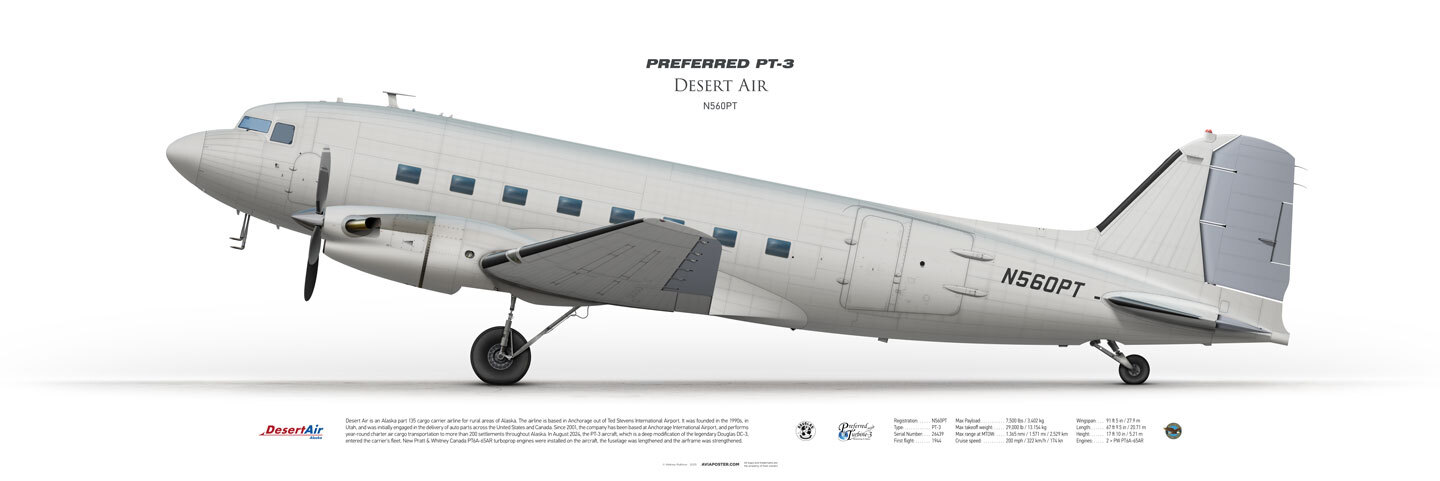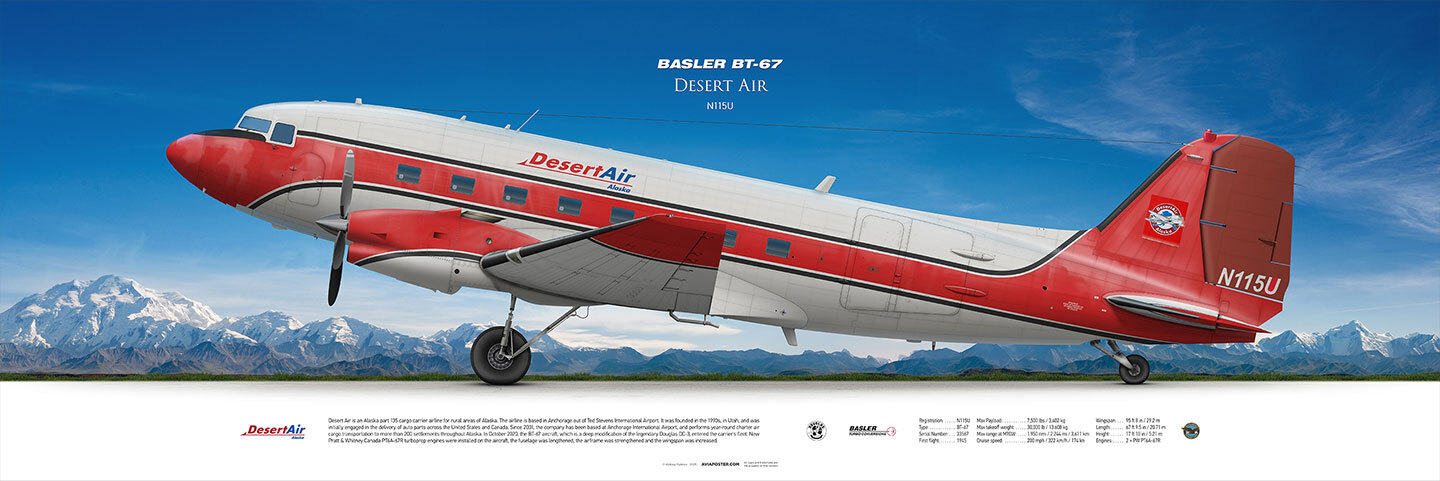Conroy Aircraft: Turbo Dreams Over Santa Barbara
In the late 1960s, something extraordinary was brewing in the hangars of Conroy Aircraft. Jack Conroy, the company’s founder, was a man with a boundless imagination and hands that never rested. He’d already made waves with his colossal “Guppy” planes – cargo beasts built to haul rocket parts – but now his eyes settled on the good old DC-3. Jack looked at these machines, still gathering dust on airfields, and thought, “What if we gave them some serious engines?” And so began the story of the Dakota’s turbocharged rebirth.
Turbo-Three: The First Step to Turbines
It all kicked off with the Conroy Turbo-Three. In 1969, they rolled a DC-3 into the workshop, stripped off its wartime Pratt & Whitney piston engines, and fitted two Rolls-Royce Dart Mk. 510 turboprops. Jack scavenged these engines from a crashed Vickers Viscount – waste not, want not! The turbines were lighter than the old motors, so they had to nudge them forward to keep the plane balanced. When the Turbo-Three first roared into the sky on May 13, 1969, it showed what it could do: speed jumped from 270 km/h to 346 km/h, and the engine hum grew a touch quieter and smoother.
This plane strutted its stuff at the Paris Air Show that same year, turning heads and raising eyebrows. It could’ve flown on peacefully, but Jack wasn’t one to stop. The Turbo-Three was just the first step, not the last.
Super Turbo-Three: The Super Veteran
Next up was the Super Turbo-Three. Conroy didn’t start with a standard DC-3 this time – they picked its later cousin, the Super DC-3, with slightly larger wings and a beefier tail. Once again, two Rolls-Royce Darts took their places on the wings, but now they were mounted at the back of the nacelles to improve airflow. The plane was zippy, but not without flaws: the small Viscount props didn’t play well with the bulky nacelles and landing gear, sapping some thrust. Plus, it needed a 1800-meter runway to take off – not quite what you’d expect from a Dakota that could land on a handkerchief.
The Super Turbo-Three made an appearance at air races in Mojave in 1975, but its story wasn’t a blockbuster. It sat for years at an airfield in Groton, Connecticut, until 1984, when a taxiing Lockheed Hercules clipped its cockpit. After that, the old-timer quietly faded, surrendering to rust.
In the late 1960s, something extraordinary was brewing in the hangars of Conroy Aircraft. Jack Conroy, the company’s founder, was a man with a boundless imagination and hands that never rested. He’d already made waves with his colossal “Guppy” planes – cargo beasts built to haul rocket parts – but now his eyes settled on the good old DC-3. Jack looked at these machines, still gathering dust on airfields, and thought, “What if we gave them some serious engines?” And so began the story of the Dakota’s turbocharged rebirth.
Turbo-Three: The First Step to Turbines
It all kicked off with the Conroy Turbo-Three. In 1969, they rolled a DC-3 into the workshop, stripped off its wartime Pratt & Whitney piston engines, and fitted two Rolls-Royce Dart Mk. 510 turboprops. Jack scavenged these engines from a crashed Vickers Viscount – waste not, want not! The turbines were lighter than the old motors, so they had to nudge them forward to keep the plane balanced. When the Turbo-Three first roared into the sky on May 13, 1969, it showed what it could do: speed jumped from 270 km/h to 346 km/h, and the engine hum grew a touch quieter and smoother.
This plane strutted its stuff at the Paris Air Show that same year, turning heads and raising eyebrows. It could’ve flown on peacefully, but Jack wasn’t one to stop. The Turbo-Three was just the first step, not the last.
Super Turbo-Three: The Super Veteran
Next up was the Super Turbo-Three. Conroy didn’t start with a standard DC-3 this time – they picked its later cousin, the Super DC-3, with slightly larger wings and a beefier tail. Once again, two Rolls-Royce Darts took their places on the wings, but now they were mounted at the back of the nacelles to improve airflow. The plane was zippy, but not without flaws: the small Viscount props didn’t play well with the bulky nacelles and landing gear, sapping some thrust. Plus, it needed a 1800-meter runway to take off – not quite what you’d expect from a Dakota that could land on a handkerchief.
The Super Turbo-Three made an appearance at air races in Mojave in 1975, but its story wasn’t a blockbuster. It sat for years at an airfield in Groton, Connecticut, until 1984, when a taxiing Lockheed Hercules clipped its cockpit. After that, the old-timer quietly faded, surrendering to rust.

Tri-Turbo-Three: The Three-Engine Rebel
Now, here’s the star of the show: the Conroy Tri-Turbo-Three. Jack Conroy decided two engines were too tame, and in 1977, the world met a DC-3 with three Pratt & Whitney Canada PT6A-45 turbines. Two motors stayed on the wings, while the third perched proudly in the nose, right where a weather radar might’ve been. Why? Turbines are lighter than pistons, and the nose engine kept the center of gravity in check without rebuilding the whole fuselage. Plus, it added raw power, boosting cruising speed to 370 km/h.
The Tri-Turbo-Three first flew on November 2, 1977, and it was no mere experiment. They fitted it with skis and sent it to the polar wilds – first to the North Pole, based in Resolute Bay, Canada, then to Antarctica. There, it became a true hero, hauling cargo, rescue teams, and even tourists. In 1983, it carried the “Seven Summits” expedition to Mount Vinson in Antarctica – the first climb of that peak. The nose engine could be shut off in flight, dropping speed to 290 km/h but stretching range – a clever trick for long hauls over icy deserts.
Fate, though, had other plans. In 1982, while under repair in Santa Barbara, a fire broke out in the cockpit. The blaze gutted Jack’s dream, and though a second model was later built, it never went into production. The Federal Aviation Administration (FAA) didn’t help, demanding full certification as a new aircraft, not just a modification. At a cost of $600,000 – a fortune back then – and mired in red tape, the project fizzled out.
What Made Conroy Special?
Conroy’s modifications were more than engineering stunts. Jack saw the DC-3 not as an outdated relic but as a platform for something new. Turbines promised speed, less weight, and fuel savings – Jet-A was cheaper and easier to find than Avgas in remote corners. The Tri-Turbo-Three, for instance, could carry a ton more cargo than a standard DC-3 and fly faster. But the world wasn’t ready: small operators couldn’t afford the upgrades, and big players opted for shiny new Convairs or Fokkers.
Conroy Aircraft left a blazing mark on the DC-3’s history. The Turbo-Three proved the old-timer could be spry, the Super Turbo-Three aimed higher, and the Tri-Turbo-Three was a rebel with three beating hearts. They didn’t conquer the skies in droves, but they showed that even decades after its first flight, the DC-3 still sparked grand adventures. As long as those old blueprints gather dust in some hangar, I’m sure the spirit of these machines will find its next Jack Conroy.
Heirs of a Winged Legend
The Story of the Basler BT-67 and Preferred PT-3
Winter 1935 was a cold one, but the hangars of Douglas Aircraft Company in California were buzzing with life. On December 17, a plane took to the skies for the first time, destined to become a legend – the Douglas DC-3. This twin-engine beauty, with its sleek lines and steadfast spirit, quickly won the world over. Airlines loved it for its comfort, the military for its versatility, and pilots for forgiving their mistakes and bringing them home safe, even in the toughest conditions. Nearly a century later, the DC-3 is still flying. But how does this old-timer keep up in an age of jetliners and drones? Simple: it evolved. Today, I’ll tell you the story of two of its turboprop heirs – the Basler BT-67 and Preferred PT-3 – that breathed new life into the veteran.
Basler BT-67: A Rebirth in Oshkosh
In the small town of Oshkosh, Wisconsin, a company called Basler Turbo Conversions sprang up in 1990. Its founders looked at the aging fuselages of DC-3s and their military cousin, the C-47, gathering dust in hangars worldwide, and thought, “These machines can still soar.” And so began the story of the BT-67 – a plane that took the best of the past and laced it with modern tech.
Picture this: a battle-scarred C-47, a veteran of World War II, rolls into the workshop. They strip it down to the last bolt, inspecting every frame, every rivet. Then the magic starts. Out go the old, rumbling Wright or Pratt & Whitney piston engines, replaced by shiny new Pratt & Whitney Canada PT6A-67R turboprops – 1424 horsepower apiece. These engines aren’t just more powerful; they’re quieter and sip fuel – a big plus for long hauls. The props get an upgrade too: five-blade Hartzells that pull the plane forward with fresh vigor.
But that’s not all. They stretch the fuselage by a full meter, adding a section before the wing. Inside, it’s roomier – more space for cargo or passengers. The wings are reinforced, their shape tweaked slightly to hug the air better. And the cockpit? It’s a leap into the 21st century: no more clunky analog gauges, just screens, GPS, and cutting-edge comms. When they roll this plane out of the hangar, it’s no longer just an old DC-3 – it’s a Basler BT-67, primed for new adventures.
And those adventures come fast. In Antarctica, where the cold bites hard, the BT-67 slips on skis and ferries scientists to polar stations. With a payload of nearly 6 tons and the ability to land on snow, it’s the king of icy wastes. In Colombia, it dives into jungles, dropping special forces to battle drug cartels. Somewhere in Africa, it hauls aid to villages unreachable by truck. In the hands of geologists, it skims low over the earth, sniffing out oil or minerals. Since 1990, about seventy of these planes have been built, each tailored like a bespoke suit for its owner.
Preferred PT-3: The Quiet Contender
Now, let’s shift to another story – less flashy, but no less intriguing. Somewhere in the U.S., Greenwich Aircraft Corporation also decided to give the DC-3 a second shot at glory. Enter the Preferred PT-3 – another turboprop heir to the legend. Its path echoes the BT-67’s, but with its own twist.

In Greenwich’s workshops, old airframes are taken apart and reborn. The engines? Pratt & Whitney Canada again, but with options: PT6A-65AR or PT6A-67R, depending on what the client needs. The fuselage gets stretched, like the Basler’s, though the exact size can vary. Inside, it’s all upgraded – new electronics, stronger structures, reliability dialed to eleven. But where the BT-67 is a workhorse for the masses, the Preferred PT-3 feels more like a custom job. It’s ordered by those with specific missions in mind – military ops, scientific expeditions, or things you won’t read about in the papers.
Less is known about the Preferred PT-3 than its famous sibling. Word is, only a handful were built, each a rare bird you won’t spot at just any airfield. But those who fly it swear by the same dependability and simplicity that made the original DC-3 a star.
Why Are They Still Flying?
Sometimes I wonder: how do these old-timers, pushing a century, keep going? The answer’s as straightforward as the DC-3 itself. Its airframe is a masterpiece of engineering – solid as a rock, ready for anything. Turboprop engines made it thriftier and easier to maintain than old piston rigs, and cheaper than modern jets. Most importantly, they do what others can’t: land on tiny strips, take off from dirt or snow, and operate where “infrastructure” is just a fancy word in a dictionary.
Take Antarctica. A jetliner wouldn’t dare – it needs a long concrete runway, and there’s none to be found. But a BT-67 on skis glides onto a glacier, delivering whatever’s needed. Or South American jungles: while helicopters wrestle with short ranges, a turboprop DC-3 hauls cargo hundreds of kilometers. And there’s no shortage of old airframes yet – thousands of C-47s and DC-3s wait in hangars worldwide for their next chapter.
Two Brothers, Two Fates
Put a BT-67 and a Preferred PT-3 side by side, and the differences stand out. The Basler is a crowd-pleaser, flying everywhere from polar ice to tropics. The Preferred is more secretive, built for those who know exactly what they need. Different engines, different assembly styles, but one soul – the soul of the DC-3, which never grows old.
What’s Next?
Sometimes I look at these planes and wonder: how much longer will they last? The supply of old fuselages isn’t endless, and the world keeps demanding greener, safer machines. Basler’s already tinkering with hybrid engines, trying to give the platform another breath of life. But even if their time comes to an end, they’ll bow out proud. The BT-67 and Preferred PT-3 aren’t just aircraft. They’re a story of a brilliant idea from 1935 that keeps living, evolving, and serving humanity nearly a century later.
And as long as those props hum somewhere in the sky, I know the legend hasn’t died. It’s just slipped into a new suit and taken flight again
